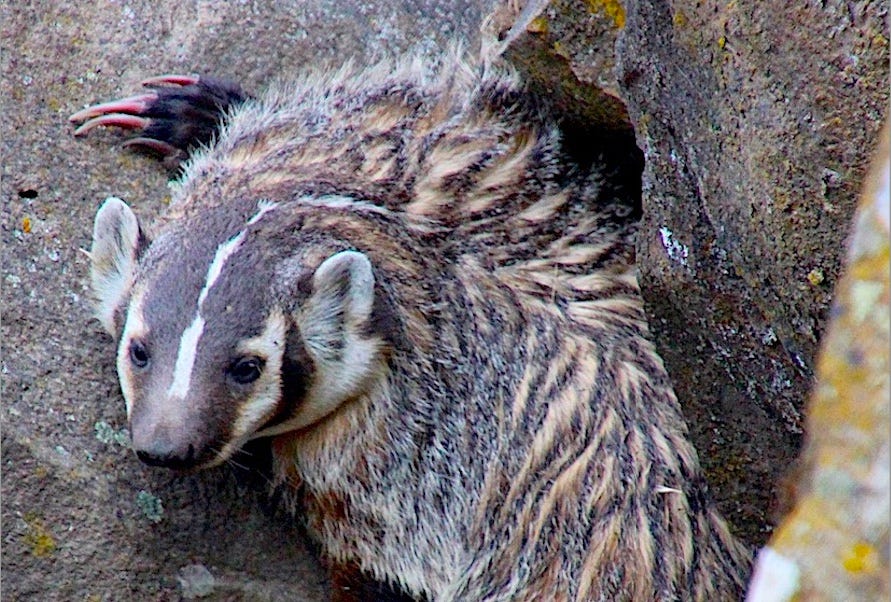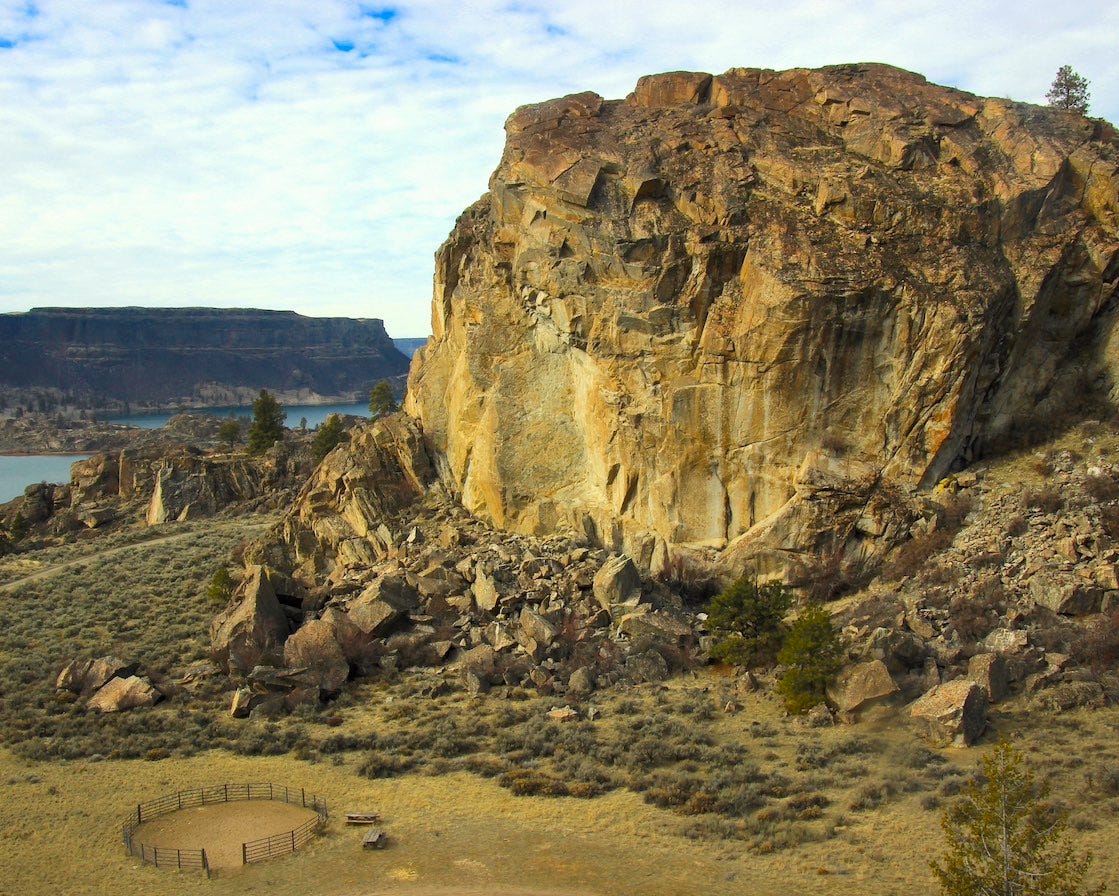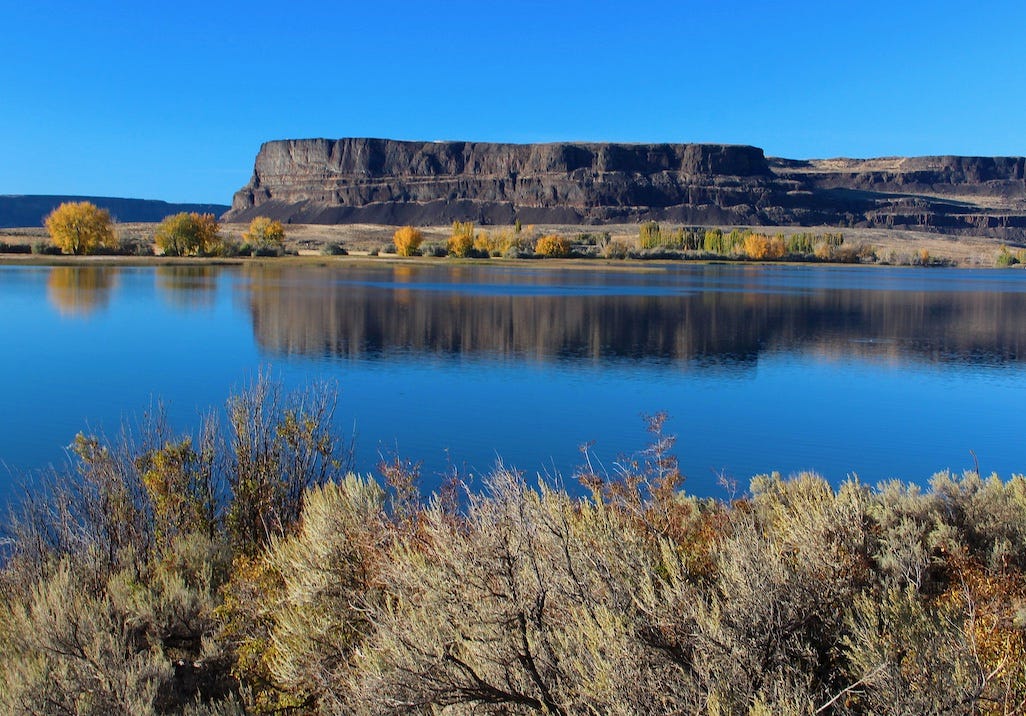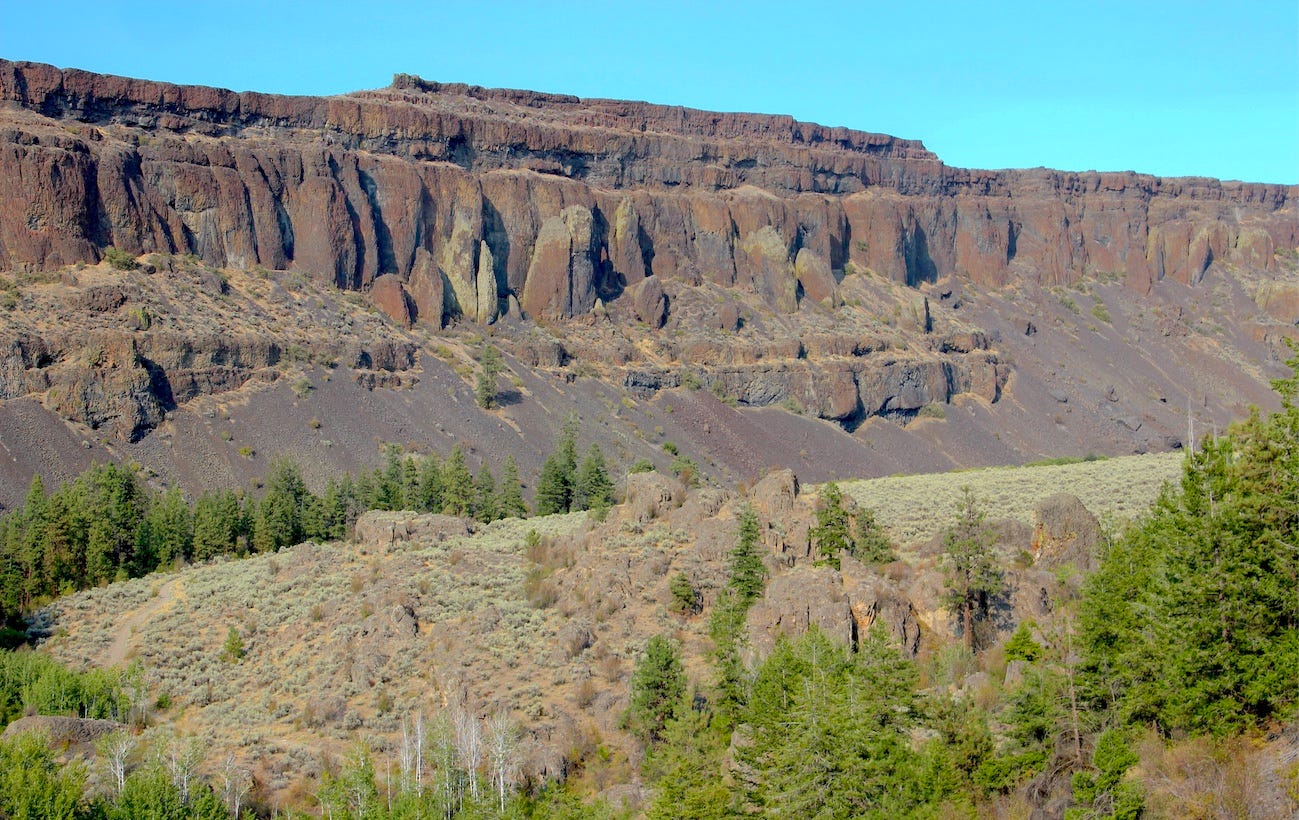Thursday's postcard, and how to find and appreciate Northrup Canyon
May 11, 2023
American badger on a basalt scarp on the Columbia Plateau trail near Lamont, WA
Grand Coulee’s companion cataract is well worth the search
A challenge in writing about Grand Coulee is the problem of scale—the difficulty in trying to describe scenes so over-sized they strain credulity.
That would be true even without Northrup Canyon, a hidden annex to Grand Coulee carved into the highlands south of Electric City.
A century ago, J Harlen Bretz took fire from his critics in the American geologic establishment for his provocative (and correct) thesis that a catastrophic flood had created Grand Coulee and other dramatic features in the terrain of the lower Columbia Basin. In response, he couldn’t resist inserting what amounted to throw-down arguments in the text of his papers. His first-hand witness to the scene at Northrup Canyon was one of those arguments.
“Again and again,” Bretz wrote in 1932, “the writer has asked others and himself ‘Where is the dangerously weak point in the [great] flood hypothesis?’ One can stand on the brink of Northrup Canyon and aver with confidence that it can never be satisfactorily explained except as an extinct Niagara [Falls].”
As the decades passed, broader views would come from satellite and high altitude photography. But there’s nothing quite like staring up at the water-shaped scarps at Northrup Canyon, with their massive rounded pillars and lobes, to translate the power of the force behind its creation.
Round pen at Northrup equestrian area beneath “Gibraltar,” with Steamboat Rock in the distance
River-carved canyons, even very large canyons, are V-shaped. Because they were created in a much different fashion, the scabland canyons are usually U-shaped, and none more so than upper Grand Coulee, between Coulee City to the south, and Electric City to the north.
At Grand Coulee the epic floods created a pair of enormous cataracts twenty miles apart. At Dry Falls, just south of Coulee City, it is as though the earth clock stopped at 11:55 p.m. of the Pleistocene epoch. What one sees today is basically what you would have seen 12,000 years ago, at the end of the last ice age—minus the visitor’s center. It is the intact remains of a once-astounding waterfall, one that is commonly described as having five times the width of Niagara Falls, and more than twice as deep. Today it just lacks water, except for the slack water in the plunge pool lakes below its face.
The northern cataract—which retreated to where Electric City is today—was even larger than the one at Dry Falls. Eventually, nearly all of the cataract was swept away under the constant assault of the late Pleistocene floodwaters. What it would have looked like is left to our imaginations
Steamboat Rock in Upper Grand Coulee
It helps that a large, orphan chunk of it survived. We know it as Steamboat Rock, a popular destination with a sprawling campground surrounded by Banks Lake, a reservoir that receives water pumped uphill from Grand Coulee dam. The route to Steamboat Rock is state route 155 which hugs the east side of the coulee between Coulee City and Electric City. The highway connects to Steamboat Rock via a natural land bridge.
Steamboat Rock is far enough from side walls of Grand Coulee that it can trick the mind. It can appear to be an uplift rising out of Banks Lake reservoir rather than as a remnant island of the surrounding Waterville Plateau. It is generally flat on top, except for a 100 foot-deep cleft that cuts across its width near its southern end. Geologists think the deep groove may have been initiated by a stream that pre-dated the glacial floodwaters. Thus, if the scene were not head-spinning enough, here you have a nested doll of geology: a canyon hanging in the sky on a peninsula within a 1,000 foot deep coulee.
In the midst of this grandeur Northrup Canyon can be overlooked, in large part because it’s not visible from the highway. Although there’s a Northrup Canyon sign on state route 155 it is not a large one. A gravel road winds up through a crease in the ramparts northeast of Steamboat Rock. What’s immediately strange—given that the standard issue bedrock of the scablands is dark basalt—is that granite is now everywhere. And not just a few light-colored stones
Flood carved basalt in the north wall at Northrup Canyon, with granitic bedrock amidst pines in the foreground
Near the mouth of Northrup Canyon, for example, is what the rock climbers call “Gibraltar.” It is a massive granitic monolith, towering well over 100 feet above the round pen of the canyon’s equestrian area.
A quarter mile further up the road—pinched between a granite ridge and the soaring basalt escarpment that frames the southern rim—is the canyon’s trailhead. By then a visitor will have noticed something unusual for this part of the Columbia Basin. Trees. Within view are hundreds of mature pines and a large grove of aspen and red-twig dogwood watered by Northrup Creek. The pines offer winter roosts for eagles and the riparian habitat along the creek supports a number of other avian species that attract birdwatchers year round.
The further you hike to the east, the wider the canyon becomes. It eventually branches with one broad arm headed off to the northeast, and the other to the southeast. The “Y” shape of the canyon enhances the dramatic relief Bretz wrote about nearly a century ago because there are soaring cliffs on three sides.
I’ll defer to the camera to better convey the surreal flood features of Northrup Canyon. But, to my eyes, the interplay between the granitic rock and the basalt is mesmerizing. To the north beyond Gibraltar Rock, for example, there is not only a high, toothy rimrock of basalt, but parapets of granite. The granite is the true bedrock of the area and part of the same granitic complex that anchors Grand Coulee Dam to the north.
Contact between granite bedrock and overlying and much younger basalt in Northrup Canyon
The basalt came millions of years later and covered the granite. Then—in much more recent time—came the pulses of glacial floodwaters, which arrived with such violence as to strip away much of the weaker basalt cover, re-exposing the granite. One weird result is a low ridge of exposed granite in the middle of the lower canyon, with towering walls of basalt on either side. Here, on the north side of the granite ridge, Northrup Creek has naturally carved a gutter-like groove in the granite not far from where you can actually see, up close, the contact between basalt and granite.
The main trail into the canyon goes approximately three miles to Northrup Lake, a classic plunge pool surrounded by rimrock. It’s an especially popular trek in the fall, when the lake is surrounded by brilliantly colored foliage and the summer heat has passed. On the way out (and back) you’ll pass by the old Northrup homestead which is about where the trail turns northward and ascends into loose stands of pines and granite outcroppings
Northrup Lake in autumn
From the trailhead near the canyon you can also find what is literally “the old wagon trail” that ascends the grade up to the top of the southern rimrock. But this trail is off-limits from mid-November to mid-March to protect roosting eagles.
The main trail can be very icy (from trampled and re-frozen snow) in the winter. Rattlesnakes are an issue in late spring and summer, and I would recommend flashlights in spring and fall, just in case you linger longer than you may expect, and find yourselves hiking back in the fading light.
—tjc








